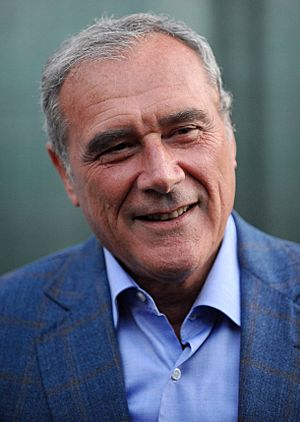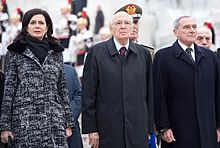Pietro Grasso facts for kids
Quick facts for kids
Pietro Grasso
|
|
|---|---|

Grasso in 2012
|
|
| President of the Senate of the Republic | |
| In office 16 March 2013 – 22 March 2018 |
|
| Preceded by | Renato Schifani |
| Succeeded by | Elisabetta Casellati |
| Acting President of Italy | |
| In office 14 January 2015 – 3 February 2015 |
|
| Prime Minister | Matteo Renzi |
| Preceded by | Giorgio Napolitano |
| Succeeded by | Sergio Mattarella |
| Member of the Senate of the Republic | |
| In office 15 March 2013 – 12 October 2022 |
|
| Constituency | Lazio (2013–2018) Sicily (2018–2022) |
| National Antimafia Prosecutor | |
| In office 11 October 2005 – 27 December 2012 |
|
| Preceded by | Pierluigi Vigna |
| Succeeded by | Giusto Sciacchitano |
| Personal details | |
| Born | 1 January 1945 Licata, Kingdom of Italy |
| Political party | PD (2013–2017) Independent (since 2018) |
| Other political affiliations |
LeU (2017–2022) |
| Spouse |
Maria Fedele
(m. 1970; died 2025) |
| Children | 1 son |
| Alma mater | University of Palermo |
| Signature |  |
Pietro Grasso (born 1 January 1945), also known as Piero Grasso, is an Italian former judge and politician. He is famous for his work fighting organized crime, especially the Sicilian Mafia. He also served as the President of the Senate from 2013 to 2018.
Grasso became the Acting President of Italy on 14 January 2015. This happened when the previous president, Giorgio Napolitano, resigned. Grasso served in this important role until Sergio Mattarella was sworn in on 3 February 2015.
Contents
Pietro Grasso's Career in Law
Pietro Grasso had a long and important career as a judge. He worked hard to fight against organized crime in Italy.
The Big Mafia Trial
In 1984, Grasso became a judge in a very large trial against the Sicilian Mafia. This trial was called the maxiprocesso, which means "maximum trial" in Italian. It was a huge case with 475 people accused of crimes.
The trial took place from 1986 to 1987. Pietro Grasso, along with the main judge Alfonso Giordano, wrote the final judgment. This judgment was over 8,000 pages long. It led to 19 life sentences and more than 2,600 years in prison for the criminals.
After this big trial, Grasso became an advisor to the Anti-Mafia Commission. He also worked for the Ministry of Justice. He helped coordinate investigations into major bombings that happened in 1992 and 1993.
Fighting Crime in Palermo
In August 1999, Grasso became the Public Prosecutor in Palermo, a city in Sicily. Under his leadership, from 2000 to 2004, many criminals were arrested. About 1,779 people were arrested for Mafia-related crimes. This included 13 of the 30 most dangerous fugitives.
During this time, the Palermo prosecutor's office gave out 380 life sentences. They also gave hundreds of other sentences, adding up to thousands of years in prison. This shows how effective his work was in fighting crime.
National Antimafia Prosecutor
On 11 October 2005, Pietro Grasso was chosen for a very important job. He became the National Antimafia Prosecutor. This role meant he was in charge of fighting organized crime across all of Italy. He took over from Pierluigi Vigna.
One of the biggest successes during his time was the capture of Bernardo Provenzano. Provenzano was a very powerful Mafia boss who had been hiding since 1963. Grasso's team helped capture him on 11 April 2006, after many years of searching.
In September 2006, Grasso's team also helped with "Operation Odyssey." This operation stopped Mafia groups in Vibo Valentia from controlling construction and supplies for holiday resorts. This operation led to 41 arrests.
Teaching About the Mafia
From September 2012, Pietro Grasso hosted a TV show called "Lessons Mafia" on Rai History. This show had 12 episodes. It was a project to teach young people about the secrets of the Mafia, also known as Cosa Nostra.
The program was inspired by similar lessons given by Giovanni Falcone in 1992. Grasso agreed to tell young people about the Mafia system. He explained its rules, stories, and how it worked. This helped educate a new generation about the dangers of organized crime.
Pietro Grasso's Political Career
After his long career as a judge, Pietro Grasso entered politics.
Becoming a Senator
On 27 December 2012, Grasso decided to run for election. He joined the centre-left Democratic Party. On 8 January 2013, he was chosen as a candidate for the Italian Senate for the Lazio region.
He was elected in the 2013 general election. As a new senator, he supported a project to improve anti-corruption laws. This project aimed to make laws stronger against political corruption and Mafia influence.
President of the Senate

On 16 March 2013, Pietro Grasso was elected President of the Senate. This is a very important position in the Italian Parliament. He won with 137 votes.
As President of the Senate, he had to make important decisions. One decision involved a case against former Prime Minister Silvio Berlusconi. Grasso decided that the Senate should be involved in the case, even though some disagreed.
On 14 January 2015, Grasso became the Acting President of the Italian Republic. This happened when President Giorgio Napolitano resigned. Grasso served in this role until Sergio Mattarella became the new president on 3 February 2015.
Grasso left the Democratic Party on 26 October 2017.
Leader of Free and Equal
On 3 December 2017, Grasso became the leader of Free and Equal (LeU). This was a new group of left-wing political parties. It included the Democratic and Progressive Movement, Italian Left, and Possible.
See also
 In Spanish: Pietro Grasso para niños
In Spanish: Pietro Grasso para niños

